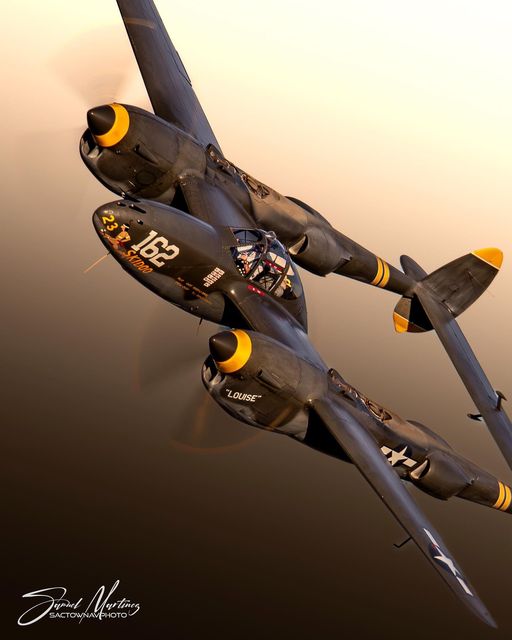The Lockheed P-38 Lightning would become one of the most fearsome fighters of the Second World War, and one that was instantly recognizable.
The Second World War is usually seen by many to be the technology war. Military tech advanced quickly compared to where it had been during the First World War, as aircraft get faster and more powerful, tanks became bigger and better and guns get more fearsome. Aircraft saw perhaps some of the quickest advances as we went from machines like the Sopwith Camel, to the Supermarine Spitfire. The United States quickly improved its own arsenal of aircraft, and one product of that was the fearsome P-38 Lightning.
The P-38 was one of the most unusual looking machines of the entire conflict. Its twin-tail design meant it was instantly recognizable. The aircraft saw use from 1941 by the US Army Air Force and well past the end of the war, retired by the United States Air Force in 1949. However, the Honduran Air Force retired it only in 1965. The P-38 would become one of the first Allied fighters that had strong performance at high altitudes, and it would become the only American fighter that was in large-scale production throughout the entire US involvement in the Second World War.
The Development Of The Unique P-38
 via This Day In Aviation
via This Day In Aviation
The P-38 can trace its design right back to February 1937 when the US Army Air Corps requested a specification for a twin-engine aircraft that would become a high-altitude interceptor. A secret engineering team was then formed within Lockheed to help create the aircraft, this team becoming the foundation of the famous Skunk Works division of the company. Lockheed would go through various designs and concepts before they settled on a design that very few aircraft shared, the most notable of those perhaps being the P-61 Black Widow night fighter. Unusually too, the P-38’s engines were in fact turbosupercharged.
 via Flikr
via Flikr
The competition for the P-38 was then won in June 1937, and the first flight of what was then the YP-38 was on January 27th 1939. A record flight from California to New York saw the initial prototype wrecked upon a crashed landing, but the performance was so good on that flight that 13 more YP-38s were quickly ordered. Manufacturing would fall behind schedule initially, before the final of the initial 13 aircraft then introduced in June 1941. Deliveries to the United States Army Air Force would properly begin at the start of 1942, after the Japanese had invaded Pearl Harbor and brought the United States into the conflict.
The P-38 Enters The Aerial War Above Europe
 via US Air Force
via US Air Force
The P-38 would perhaps become most famous for its operations in the European theatre of war and in particular over North Africa and Italy. The first kill for a P-38 was when an aircraft of the 27th Fighter Squadron, assisted by another US aircraft from the 33rd Squadron, shot down a Focke-Wulf Fw 200 Condor over the Atlantic. This was also the first Luftwaffe aircraft destroyed by the US Army Air Force. The P-38 would soon earn kills in North Africa, with Lieutenant Mark Shipman shooting down an Italian aircraft as well as a Bf 109 fighter and Me 323 Gigant transporter.
 via World War Photos
via World War Photos
After initial mixed results, the P-38 would soon start to make a name for itself. Johannes Steinhoff of the JG 77 in North Africa would remark on how the P-38’s turning radius was smaller than that of the Bf 109, making it a formidable foe in a dogfight. German ace Franz Stigler would say they could turn inside the Bf 109 with ease, and could go from level flight to climbing almost instantaneously. The Lightning would soon make a name for itself as a long-range escort fighter in Western Europe, serving in this role until the P-51 Mustang arrived.
The Fork-Tailed Devil Earns Its Nickname
 via War History Online
via War History Online
The P-38 would earn its nickname in April 1943. Some 26 P-38Fs of the 82nd Fighter Squadron shot down 31 enemy aircraft on April 5th, establishing air superiority in that region of Africa and the German’s went on to nickname the P-38 “de Gabelschwanz Teufel” – the Fork-tailed Devil. The P-38 would also serve in the Pacific theater of the war, the fighter proving more than a match for the Japanese Mitsubishi Zero, and it was a P-38 Lightning that shot down the Mitsubishi G4M Betty bomber carrying Admiral Yamamoto, the mastermind of the Pearl Harbor attack.
One Of The Most Fearsome Fighters Of World War 2
 via General Aviation News
via General Aviation News
Despite having some issues earlier in its service career, the P-38 would serve with distinction throughout the entire US involvement in the Second World War. Several P-38s would gain notoriety during and after the war, such as Glacier Girl, a P-38 recovered from a Greenland ice cap and restored to airworthy condition. Today, there are just 26 survivors of the incredible P-38 and ten of these machines are airworthy, reminding us all the exploits of one of the war’s most fearsome fighters.
